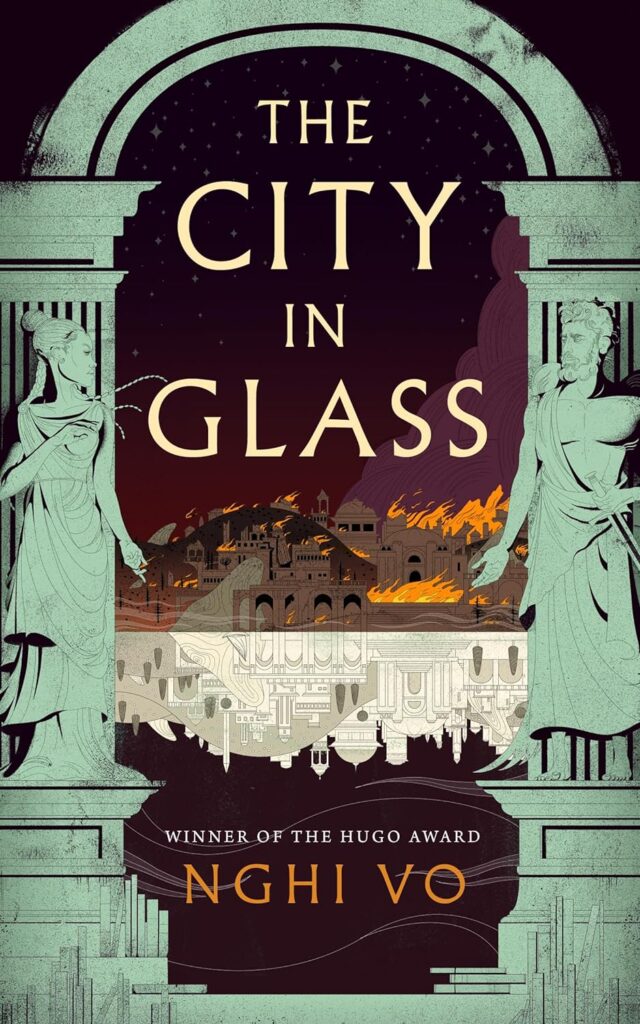
While reading Nghi Vo’s beautifully crafted and deeply imaginative The City in Glass, I kept wondering where the story was going, even what it was for. Don’t get me wrong, this short novel is completely enjoyable and brilliantly written, but I was missing something that was hard to pin down. On one level it is a love story between a demon and her adopted city of Azril. Much of the narration brings to life a great rogue’s gallery of its people and the structures she creates as well as the festivals she brings to liven the place up. The story also reveals itself over the centuries it covers as a strange relationship between a vengeful demon and a wounded angel, as forbidden a pair as can be imagined. It reminds me just a little of the friendship between Aziraphale and Crowley in Good Omens. Except different, very different.
Vitrine, a demon whose essential form is a glass case enclosed in whatever body she chooses to build for herself, presides over the city of Azril. It is a thriving city in the shadow of a mountain by the sea that rocks with its share of wealth, poverty, corruption, thievery and dancing, especially Vitrine’s favorite, the ganli. The first chapter sets the tone of Vitrine’s discovery and cultivation of the city and the huge task that faces her.
When she first arrived in the city, it seemed a dour, colorless place. The first people she can relate to are three corpses hanging from a gallows in a town square. One of them starts talking to her, the others join in, and before long Vitrine is dancing with them on the scaffold. Thereafter, she exerts her influence to nudge humans toward riches or disaster as she or their human foibles determine, all the while pushing the city to expand, building higher towers, bringing in festivals. It takes her 300 years to get Azril to the thriving state she wants, and it is just then that disaster strikes.
One day, while Vitrine is admiring her handiwork, four powerful winged angels arise out of the harbor like pillars of light and set about undoing all she has built. Vitrine sinks her claws into one of the angels, but as that one staggers upright again and rejoins the others, they proceed to mount a fearsome column of flame over the city, like an atomic bomb, that destroys everything. That wounded angel can’t go home until he gets the part of Vitrine now sunk into a deep wound completely out of his body. With nowhere else to go, he sticks around and begins a long and fraught relationship with Vitrine.
Since these two are immortal, it is very long relationship indeed. Vitrine, while angry and depressed for a time as she sorts through the smashed ruins of her city, soon gets to work rebuilding the whole thing. That takes centuries of time, during which the angel hangs out in unobtrusive ways, occasionally flies off to another city and brings her strange gifts which often backfire, merely intensifying her rage. Vitrine hates him but after hundreds of years, as she makes slow progress in restoration, she tolerates him more and more as he occasionally helps her out by disposing of vast tracts of rubble or finding places to put the remains of a city’s population.
Although these two appear to each other in something like human form, they cannot be attached to each other as humans. Over time, the relationship becomes one-sided, though Vitrine finds a way to incorporate the angel’s strength into the city. That can be looked on as a sort of love, or as close to that feeling as someone with a glass case for a heart can experience. But this is not at all a love story between angel and demon.
Most of the story is devoted to Vitrine’s reconstruction of the city and also her remembrance of what it used to be. She understands that love can be a destructive thing as well as her motive for building. And I think in the end, Vitrine is not so much attached to the physical form of the city, which has gone through its cycles of prosperity, plague, war and rebuilding. Rather she is most in love with the city as she writes about it in the book she keeps in her glass case. The City in Glass becomes a kind of love story about Vitrine and the written city that is her book, comprising all her most treasured memories.
But circling back to where I started, I took a while to see what it was I was missing in this beautiful novel. It’s really something in the nature of demons. They may go through a lot of physical changes, have their fits of rage and vengeance, and even do something constructive, like build a city. But they don’t exactly develop as characters. We learn more about Vitrine as the story of her single-minded city-building unfolds, but she doesn’t really change. The angel, by contrast, does have his ups and downs and definitely is transformed from the beginning of the book to the end. The City in Glass hits a strong and beautiful melody from the outset and plays hundreds of variations in its rich composition, but, enjoyable as it is, I missed something of the dramatic power I’ve had from other Nghi Vo stories. I’ve rarely felt this way about a book, so enamored of its style and imaginative power yet still missing that essential experience of dramatic change.
I want to thank Tor and Net Galley for an advance review copy of The City in Glass as the basis for this review, which reflects solely my own opinions.





Leave a Reply